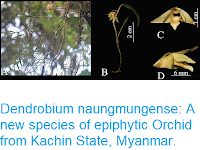False Unicorns, Chamaelirium spp., are small herbaceous plants related to Lilies, which are found in wed meadows and deciduous woodlands in Southeast and East Asia, as well as in the eastern United States. They tend to form small rosettes of leaves, flat to the ground, surrounding a central flower spike which may be as much as 30 cm high, which gives them their common name. Most species are dioecious, which is to say the male and female flowers are found on separate plants.
In a paper published in the journal Phytotaxa on 22 June 2018, Zhong-Cheng Liu of the College of Resource Environment and Tourism at Capital Normal University, and the State Key Laboratory of Biocontrol and Guangdong Provincial Key Laboratory of Plant Resources at Sun Yat-sen University, Lu Feng, also of the State Key Laboratory of Biocontrol and Guangdong Provincial Key Laboratory of Plant Resources at Sun Yatsen University, Lei Wnag, also of the College of Resource Environment and Tourism at Capital Normal University, and Wen-Bo Liao, again of the College of Resource Environment and Tourism at Capital Normal University, describe a new species of False Unicorn from Jiangxi Province in southeast China.
The new species is named Chamaelirium viridiflorum, meaning 'green-flowered'. It is a perennial herb with a rosette of flattened leaves 1-3 cm in length surrounding a central flower spike that can reach 15-22 cm. The flowers remain green throughout the flowering system, and are hermaphroditic (have both male and female features).
Chamaelirium viridiflorum. (A) & (B) Habit; (C) & (D) blade; (E) & (H) spike; (F) flower, lateral view; (G) pistil and stamen; (I) capsule. Liu et al. (2018).
The flowers were found growing in moist Moss-dominated habitats or along stream banks on rocks in subtropical evergreen broad-leaved forest at elevation of from 1200 m to 1550 m on the flanks of Mount Qiyunshan in southern Jiangxi. Only two patches of the plants were found, about two kilometres apart, in an area of woodland which is prone to disturbance by Human activities. Liu et al. do not consider they have enough information to give the plants a formal classification under the terms of the International Union for the Conservation of Nature's Red List of Threatened Species, but do consider the species to be rare, and that it's habitat should be protected.
See also...
Follow Sciency Thoughts on Facebook.







